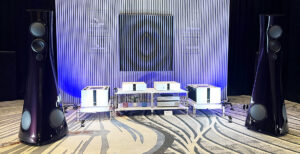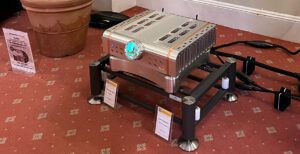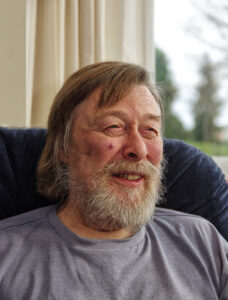
Bowers & Wilkins had a busy week. First there was the launch of the in-car audio, navigation, and comms system of the new Volvo XC90. This was swiftly followed by the announcement of the complete Maria Callas remasters, and then backed up with the announcement of the Series 2 CM loudspeaker range. Then, to add insult to injury, the company hosted a small group of European journalists at its Worthing visitors centre, on the South Coast of England.
The Volvo launch isn’t figuring here. It, like the integrated systems provided by high-level audio brands into the latest cars, provide a fascinating insight into how the next generation of audio might work, but that’s the subject of a future blog. Instead, let’s look at the Callas reissues first.
One of the most distinctive mezzo-sopranos of the 20th Century, many of Maria Callas’ recordings have never been out of print. Although there have been (many) singers with a purer and sweeter voice, and many better recordings made in the intervening 60+ years, it is Callas who is best remembered as the archetypal diva, and many of her recordings – especially her Tosca and Norma from the early 1950s – set a musical standard that has never been bettered.
However, the quality of those recordings often fail to live up to modern expectations. The last great Callas project – the EMI box set of the late 1990s – was a faithful reproduction of most of her recorded canon, but was performed at a time when the tape reconstruction tools available were primitive, at least by today’s standards. This new complete Maria Callas Complete Studio Recordings archive, on CD and available as high-resolution download availble from September 22 at the Bowers & Wilkins Society of Sound website, is an attempt to bring the sound of the master tape to the listener. And, when that master tape has sat in an archive virtually untouched for 60 years or more, that’s no easy feat.
The painstaking reconstruction process was performed at Abbey Road Studios. Part of the reason for this location is Abby Road has a vast repository of tape machines from the earliest wire recorders to the last multitrack digital models, and this has a considerable influence on the sound of the tape transfer. In some cases, the master tape was replayed on precisely the same tape recorder on which it was recorded, and this helps the process considerably (pro tape machines of the time were essentially bespoke built designs, and the idiosyncrasies of a particular recorder can influence the final result). Nevertheless, some of the tapes were in a relatively poor shape, with edit points, lost ferrite, and changes to the overall integrity of the tape itself. The tapes do contain hidden jewels, however, in the shape of original instructions written on the box by the artists, producers, and tape operators at the time. These proved pivotal in making decisions about mastering process.
It’s now possible to read the recording into a real-time and extremely sophisticated spectrum analyser, and thanks to a program called ‘Retouch’, you can clone out extraneous noises, like someone cloning out unwanted parts of an image in Adobe Photoshop. This would be an extremely controversial process, were it not for those sleeve notes on the master tape box. In 1952, when the producer wrote ‘please remove those damn Vespas’ that could be heard buzzing round La Scala at the time of the recording, this was little more than a forlorn hope – there was no way to clone out these sounds without undermining the recording itself, using tone controls. But that’s precisely what can be done now; ridding the recording of failing tubes in microphone preamps, falling music stands, and all those damn Vespas. The archivists have taken a very conservative conservationist line, though. Tape hiss remains, but tape stretching has been restored. Those direct cut recordings are carefully controlled to ensure pitch stability and any potential wow from eccentric spindle holes, but the plan was to find the least damaged recording, not excessively de-crackle an heirloom.
Programs like ‘Retouch’ do leave the final result at 24-bit, 96kHz precision, and the decision was made to provide the recordings in CD and 24/96 high-resolution, rather than artificially upsample to 24/192. The poor quality of many of the original master tapes precluded a direct-to-DSD or DXD approach. And Bowers & Wilkins is pivotal in this process, as the company’s 800D loudspeakers (driven by Classé amps) provide the mastering loudspeaker chain.
Having heard samples of the Callas archive at the mastering suite in Abbey Road a few months ago, the end result is excellent. The remastering process is clearly a labour of love for the engineers; they have not adopted a heavy-handed approach, and don’t try to bring an early 1950s mono recording into 2014 time. Instead, they have managed to make 1952 sound as good is it possibly could, using 2014 technology. Any serious opera collector will already have an opinion on Maria Callas, and that’s not the issue here. However, if your opinion is ‘the more Callas, the better’, this set is a must-have investment, whether on all 69 CDs or as a significant high-resolution download.
Next time: Bowers & Wilkins CM Series 2
http://www.bowers-wilkins.co.uk/Society_of_Sound/Society_of_Sound
By Alan Sircom
More articles from this authorRead Next From Blog
See all
AXPONA 2024 Show Report Part One
- Apr 19, 2024

Audio Show Deluxe 2024: A photo show report
- Mar 28, 2024

Paul Messenger 1949-2024: A personal tribute
- Mar 26, 2024

Bristol Hi-Fi Show 2024: See You There!
- Feb 21, 2024










